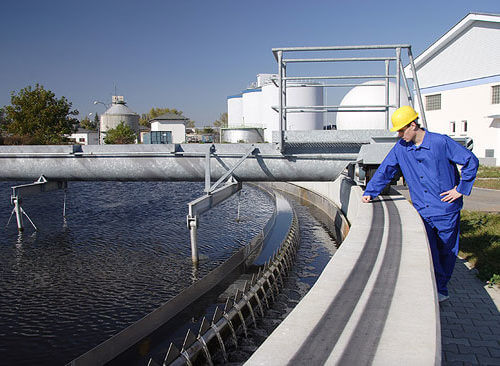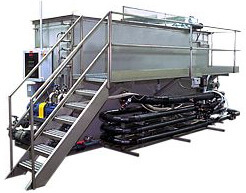Texas manufacturers who opt to install a waste water treatment system and discharge treated waste water must first obtain a discharge permit from their local city or municipality, or POTW. Manufacturers typically make this decision in an effort to save on related 3rd party transportation and disposal costs for wastes generated from their manufacturing processes.
These permits can be complex and require periodic testing, record keeping requirements and can include substantial civil and even criminal penalties for failing to properly manage and maintain the permit.

This post will briefly describe the typical components of a waste water discharge permit.
Purpose: The basic purpose of the permit is to allow discharge of nondomestic sewage from an industrial facility. These discharges must meet the parameters of the local city or municipality pretreatment standards.
Misc. Requirements: Waste water discharge permits don’t relieve the facility from obligations to comply with applicable pretreatment regulations and standards, or Local, State or Federal laws.
Outfall: The point from which the facility discharges to the drain (city or municipality drain that ultimately flows to the local POTW).
Discharge Monitoring Report (“DMR”):
- Some permits are “self monitoring” and some are not. The majority of permits for small manufacturing companies are self monitoring.
- The facility must monitor the parameters listed on the DMR forms. This includes location, frequency, sample type, applicable limits and lab testing for each parameter.
- DMRs are typically submitted quarterly or bi-annually depending on the permit.
Pretreatment Standards
- Each city or municipality have their own standards, which are referenced separately from the permit.
- General Prohibitions: There are typically several prohibited activities and parameters associated with a permit which include:
- Specific Prohibitions:
- Flammables with flash point < 140 F.
- Corrosive materials, often with PH <5 or > than 6, but these values will depend on the POTW. Note that these PH values are different from RCRA hazardous standards which stipulate PH values beyond 2-12, and DOT PH values beyond 2-12.5.
- Materials that could result in interference with the POTW, including solids and viscous materials such as wax, plastics, solid debris, oil, ash, sand, mud, metal shavings, etc.
- High temperature: Typically the materials can’t exceed 150 degrees F, but again this can vary.
- Mal odorous materials.
- Toxic gases and vapors that could present health and safety hazards to workers at the POTW.
- Discoloration agents.
- Discharge of hazardous materials.
- Discharge of radio active materials.
- Excessive “BOD,” biochemical oxygen demand and “TSS”-total suspended solids. Specific concentrations depend on the permit requirements.
- Prohibited dilutions: Permit holders are prohibited from adding materials, such as water, in an effort to manipulate effluent to by-pass permit requirements, as a substitute for pretreatment requirements.
- Specific Prohibitions:

Contaminant Limits:
- Permits typically specify local limits for contaminants such as metals. Typical metals include nickel, mercury, arsenic, cadmium, chromium, copper, cyanide, lead, silver and zinc (but there could be more depending on the local POTW).
Duty to Properly Operate and Maintain their waste water treatment system:
- Companies properly operate and maintain their systems. This includes, but not limited to: Following OEM manual, performance, adequate funding for the process, adequate staffing and training for operators, lab testing, process controls and following quality SOPs. Sometimes this includes installation and operation of backup treatment systems.
- Requirement to halt or reduce activities: Essentially, permit holders are required to discontinue or reduce treatment activities if they become aware of problems or issues which will prevent their systems from adequately treating their waste materials and thus fail to meet permit requirements. This is a self-monitoring responsibility.
- Bypassing Treatment System: Permit holders can typically only bi-pass their systems if failing to do so would create serious health and safety hazards for workers, significant property damage or no viable alternative exists. Bypass can also happen if doing so won’t result in permit violations.
- Removal of contaminants: Operators may only remove contaminants, such as sludges and bottoms, per RCRA rules and regulations (proper 3rd party transportation and disposal).
Self Monitoring:
- As mentioned previously, most permits are “self monitoring” meaning that permit holders must periodically (quarterly or bi-monthly) pull and submit test samples and send to an accredited 3rd party testing lab to test for effluent contaminants specified in the permit. This includes metals, PH, solids, etc..
- These testing requirements include meeting all applicable standards including sampling methods, testing methods, flow measurements, etc.
Reporting: Permit holders must submit reports and test results per the permit requirements. Reporting requirements include signature from authorized company representatives, certification statements, etc.
Notification:
- Permit holders must also notify the city or municipality in the event of a non-compliance, shut down, anticipated by-pass, changes to the treatment system, changes in self monitoring, discharge of hazardous or radioactive waste, etc. Typically verbal notifications must occur within 24 hours of the event and must be submitted in-writing within 5 days depending on the severity of event.
- Notifications must include details of the non-compliance, planned corrective actions, etc.
- It’s important to note that self-notifications can, and often do, result in immediate liabilities including possible civil penalties including substantial fines. For each day of non-compliance, a separate violation or penalty can be issued.
- Typically within 30 days of the notification, the permit holder must follow up with a detailed account of the violation(s) with specific planned corrective actions.
Record Keeping: Permit holders are required to maintain extensive records including monitoring, testing, calibration, maintenance of equipment, data, etc. for a period of up to 3 years.
Permit Management:
- Modifications of Permit: Permit holders may request modification(s) of their permit if they anticipate changes to their processes which would violate compliance terms of the permit. An application for modification would typically need to be submitted at least 6 months prior to the anticipated change(s) and no less than 3 months prior. These are typical reasons or justifications for changing a permit: adding new regulations, change of volume of effluent, change of terms, anticipated violations, administrative errors, transfer or change of ownership, etc.
Permit Termination: The issuing authority may terminate the permit if the holder violates the permit. Violations include failing to report estimated discharge volumes, failure to notify regarding process changes or operation, refusal of inspection by authority, intentional lying or falsifying information, failure to pay fines.
Penalties: Penalties surrounding non compliances can be severe and can include both civil and even criminal liabilities. Fines can be issued for each day of non-compliance and are typically $1,000 per day but can be higher. Intentionally falsifying records and information can result in criminal prosecutions in extreme cases. Enforceable violations include repeated violations of permit, technical review violations, violations resulting in interference or pass-through for the POTW, violations causing harm to workers or the environment, failure to provide required monitoring and reports, failure to notify non-compliances.
As you can see, waste water discharge permits are complicated and include extensive management requirements including self-monitoring, testing, reporting, etc. This requires extensive management commitment to ensure that all requirements are met, including adequate funding, staffing, training and over-site. Companies who fail to manage all of these requirements can face significant environmental fines and penalties, reputational damage, etc.
Learn more about other EPA and TCEQ environmental compliance requirements here.
Call 512-457-0374 or Click Here For A Free Consultation
